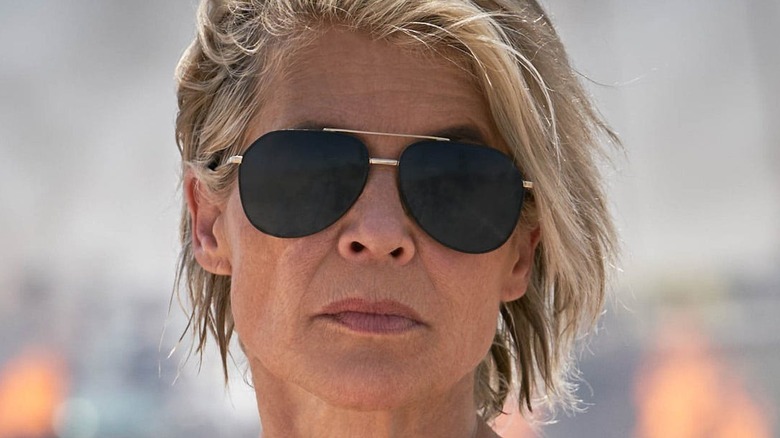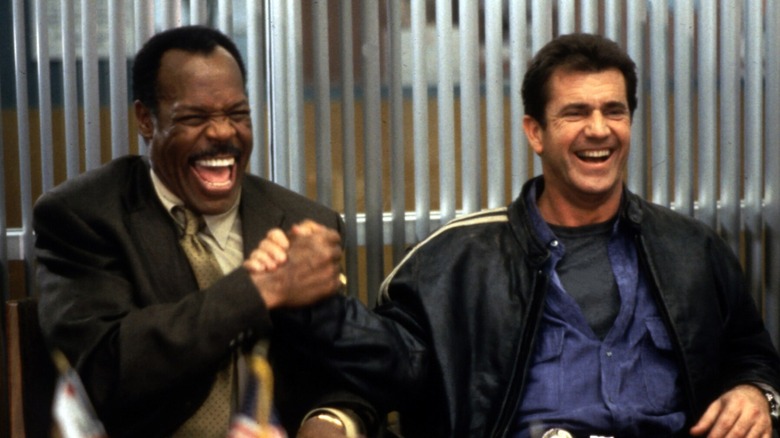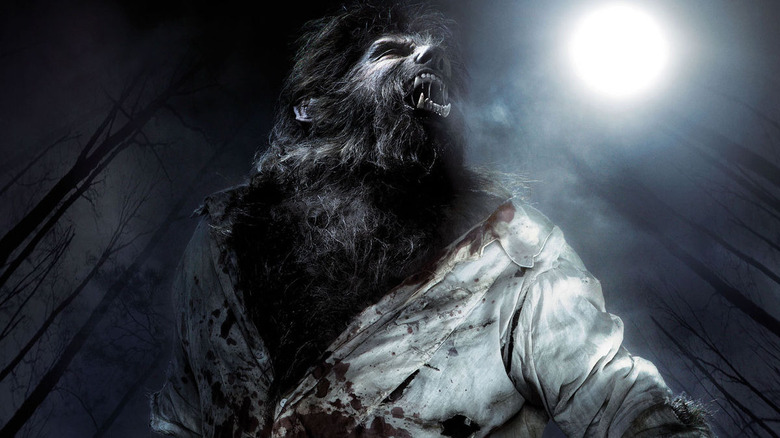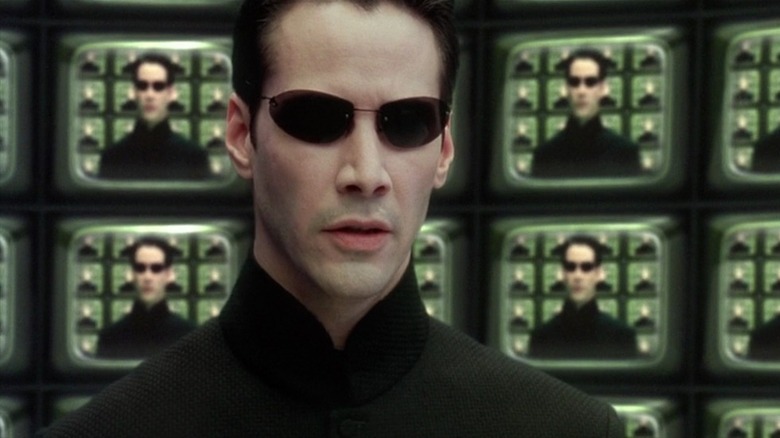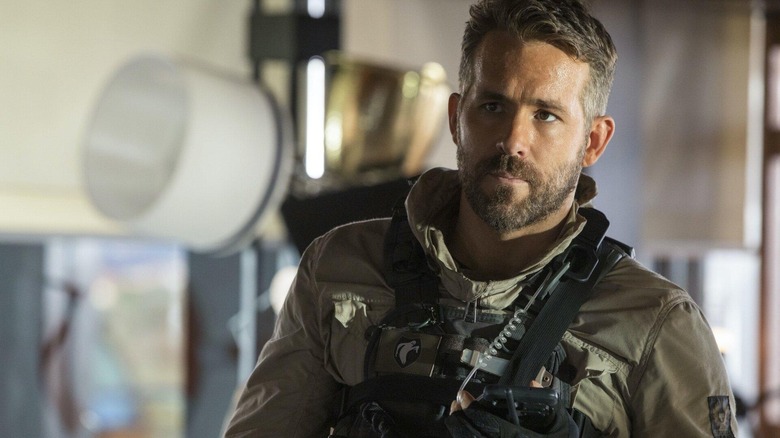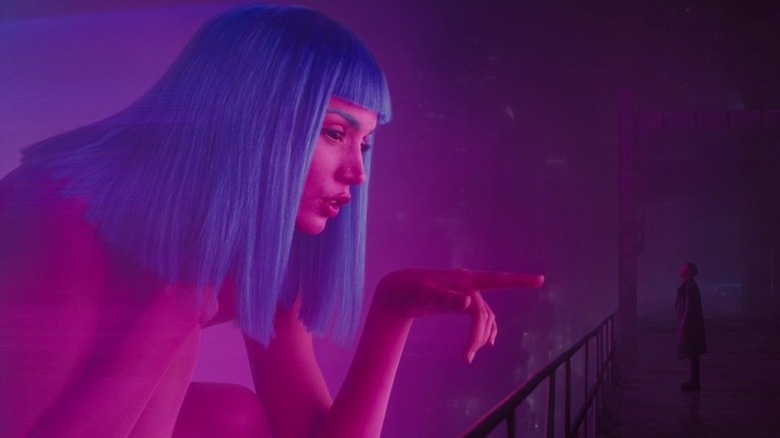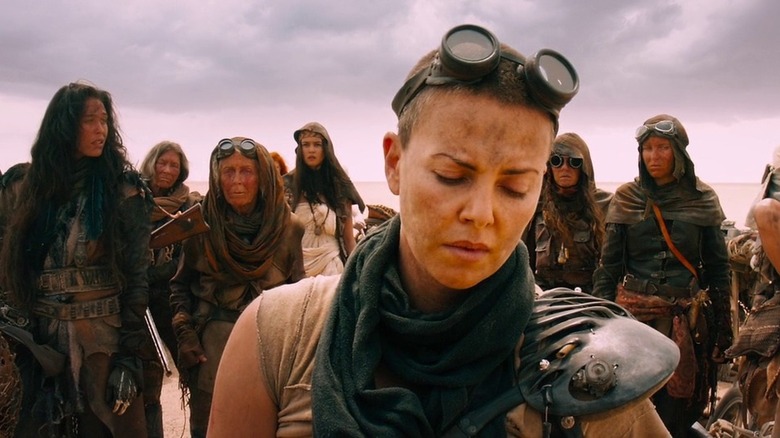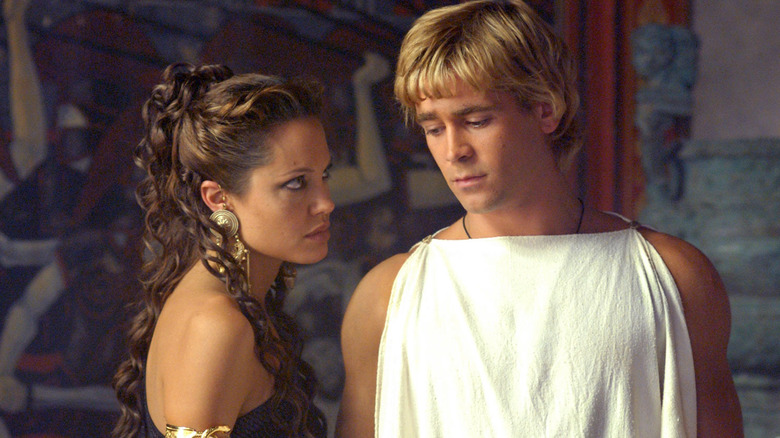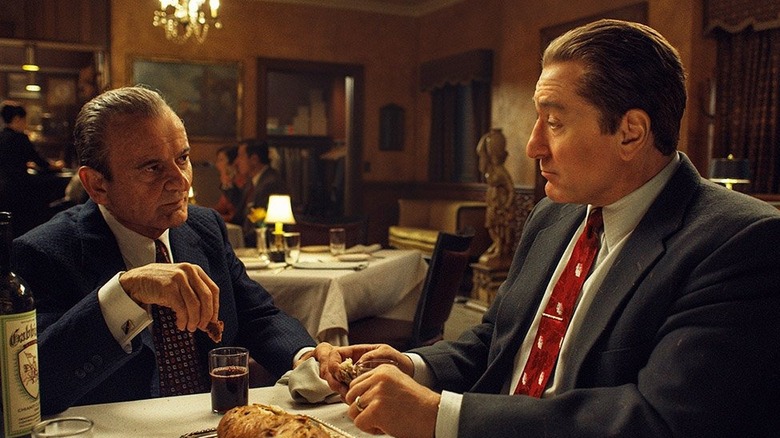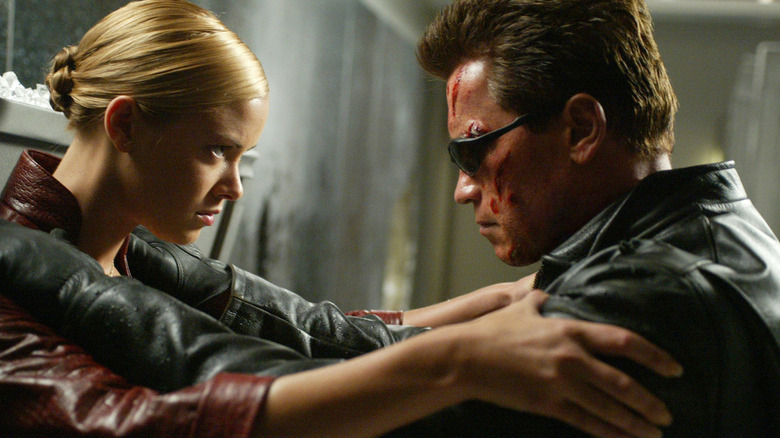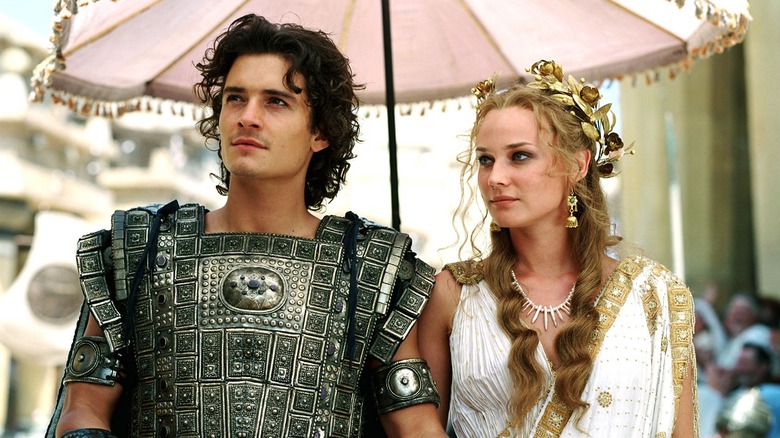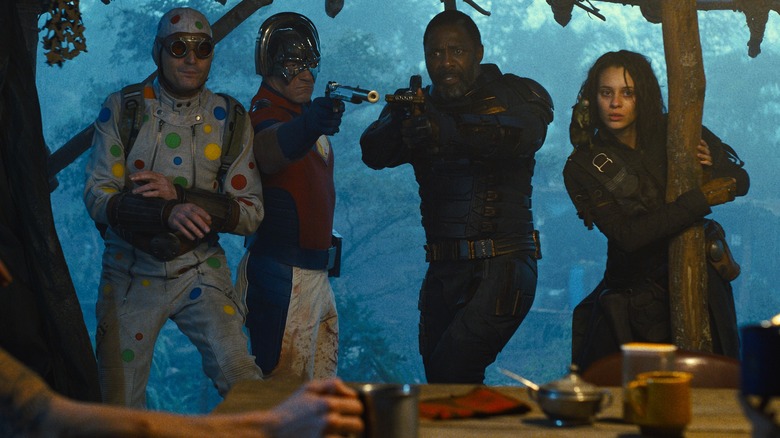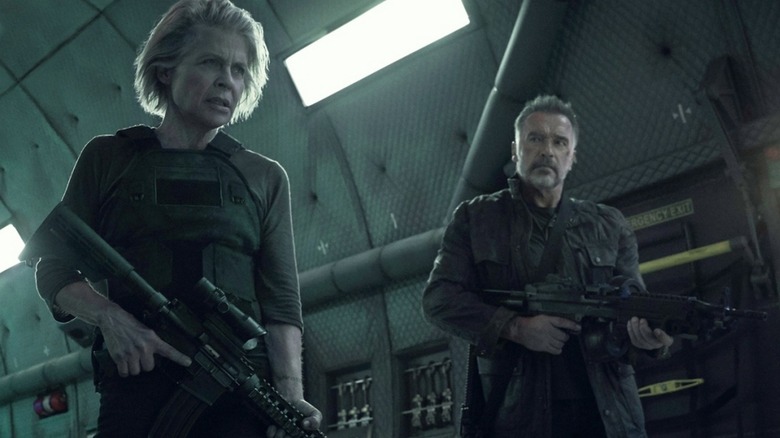Most Expensive R-Rated Movies Of All Time
If you want your movie to be a hit, you don't make it R-rated. That's the sort of wisdom that dominates Hollywood, which tends to view R-rated fare as being more restricted in who it can appeal to. Thus, R-rated films tend not to get budgets as high as PG-13 or PG-rated tentpoles. Just look at the original "Deadpool" from February 2016, which cost only $58 million to make, a fraction of the price tag for your average PG-13 superhero movie. Though "Deadpool" ended up as a major moneymaker for all involved, it was still perceived as a pre-release risk by 20th Century Fox, hence why it didn't score a gargantuan budget. But just because this approach is the norm doesn't mean that Hollywood is entirely averse to the idea of giving R-rated projects enormous price tags.
The most expensive R-rated films in history (not accounting for inflation) eschew the trend of older-skewing movies being cheaper affairs. The reasons why these particular titles got to be such notable exceptions vary wildly, with some generating their costs due to production problems while others were simply given these extreme costs from the get-go so that their full creative potential could be fulfilled. Whatever the reasons, all these projects show that R-rated movies don't have to be made as thriftily as "Deadpool."
12. Lethal Weapon 4
Back in 1987, the original "Lethal Weapon" cost just $15 million to make. It was just another buddy cop action movie at the time, so why would it have an especially notable price tag? But following that film's massive success, a series of follow-ups ensued. To keep stars like Mel Gibson happy and make each movie bigger than the last in terms of spectacle, the budgets on these "Lethal Weapon" movies grew more and more outrageous. By the time "Lethal Weapon 4" had arrived, this action film carried a $140 million budget.
Part of what made "Lethal Weapon 4" such an extra expensive affair was its quick production schedule. As recalled at Den of Geek, "Lethal Weapon 4" began filming in January 1998, just six months before it was scheduled to be released. Getting the project together in such a short span of time was not a cheap endeavor, especially when a star-studded and action-laden movie like this one was already going to be a pricey venture. In the end, despite its hefty budget, "Lethal Weapon 4" did at least manage to double its costs globally with a $285.4 million box office haul — although that might not have been quite enough to put the film in the black.
11. The Wolfman
Back in 1941, the original "The Wolf Man" cost just $180,000 to make. Even adjusting that for inflation, the budget on "The Wolf Man" would still barely exceed $3 million. What a difference roughly 70 years can make: When Universal opted to do a modern adaptation of the seminal horror tale with Benicio del Toro in the title role, the elaborate production cost an eye-popping $150 million to create. How did a movie about a furry beast chowing down on people in the 19th century end up costing so much to make?
It wasn't supposed to be this way. In a breakdown of the film's box office performance, Bomb Report noted that "The Wolfman" was originally supposed to cost $85 million after tax breaks. That figure eventually became a fantasy as production problems piled on, including a switch in directors three weeks before filming started, late in the game reshoots and alterations to the movie's visual effects. All these setbacks turned an R-rated horror title into a $150 million behemoth, a cost it could never hope to make back. Eventually, "The Wolfman" grossed $142.6 million worldwide, far short of making back its budget or turning a profit. Some expensive R-rated films can engineer enough appealing elements to attract a wide enough audience to justify their budgets. That was not the case with "The Wolfman."
10. The Matrix Reloaded
With the original "The Matrix" becoming a massive box office hit, it was inevitable that The Wachowski Sisters would be able to get a carte blanche budget for the film's successor, "The Matrix Reloaded." Warner Bros. wanted more "Matrix" and was willing to pay anything to get it. This resulted in a substantial $150 million price tag being handed over for "Reloaded," which also carried over its predecessor's R-rating. If that MPAA rating hadn't restricted moviegoers before, why would it prove a hindrance on a sequel?
It's a good thing the Wachowskis got this budget and the freedom of an R-rating since they would need a whole lot of creative space to accomplish all the costly visual effects and action scenes they envisioned for the second installment in the "Matrix" franchise. All of the ambition paid off handsomely once "The Matrix Reloaded" hit movie theaters and proceeded to be just the kind of phenomenon Warner Bros. had hoped for. Once its theatrical run had concluded, "Reloaded" had grossed $741.8 million worldwide. That wasn't just significantly above its $150 million budget, it also made this 2003 project the highest-grossing R-rated movie globally, a record it would hold until "Deadpool" arrived in 2016. Sometimes, surefire bets are surefire for a reason and that was certainly the case for "The Matrix Reloaded."
9. 6 Underground
Michael Bay always goes big in his movies, so it's no surprise that he's constantly embracing big budgets for his blockbusters. However, that usually applies to PG-13 fare like his "Transformers" movies. Originally, Bay's most expensive R-rated feature was his 2003 title "Bad Boys II" with a $130 million price tag. That all changed when Bay dipped his toes into the world of Netflix cinema for the first time with "6 Underground," a $150 million R-rated action movie that took a cue from John Hammond by "sparing no expense."
Knowing Bay's movies, it's no mystery where all that money in "6 Underground" went. There were lots of pricey explosions to dish out but even more costly was where the film was shot. "6 Underground" took its six lead characters to all sorts of lavish foreign locales. H.E. Maryam Eid Al Mheiri, CEO of Media Zone Authority – Abu Dhabi, told The Hollywood News that this project shot in "24 locations over 27 days," and that's a small portion of its four-month long shoot. Cramming so many backdrops into its principal photography, not to mention ponying up cash to afford actors like Ryan Reynolds, ensured that "6 Underground" soared above the budgets of past Michael Bay R-rated affairs. Despite putting so much money behind it, Netflix would eventually regard "6 Underground" as a disappointment, with Netflix's head of film, Scott Stuber, telling Variety in July 2021 that "we didn't feel like we got there on that one creatively."
8. Blade Runner 2049
Though reports of its budget fluctuate somewhat from outlet to outlet, "Blade Runner 2049" is widely reported to have cost $150 million to produce. That's the kind of budget you need when you're making a follow-up to a visual effects landmark like the original "Blade Runner." After the first film defined a whole new way of envisioning a dystopian future, "Blade Runner 2049" needed a sizeable budget to ensure that it could both live up to its predecessor and concoct its own distinct visual energy.
The notable price tag was also made possible due to financier Alcon Entertainment's feeling that the only way to make it in the modern film landscape was to get into the franchise game. Producer Andrew Kosove noted to The Hollywood Reporter that "if you don't have repetitive cash flow, which is a fancy way of saying being in the sequel business, you are going to be in trouble eventually." That's why Alcon gave an R-rated sci-fi title with no exploding cities or wall-to-wall action scenes like "Blade Runner 2049" such an immense budget. It was a risky gamble, as noted by Kosove himself, who called "Blade Runner 2049" a "chips-in-the-center-of-the-table exercise" for Alcon. Unfortunately, this was one big play that didn't pay off like Alcon would have wanted since "2049" only grossed $260.5 million worldwide.
7. Mad Max: Fury Road
Sometimes, a movie's budget is kept under wraps. In the case of "Mad Max: Fury Road," however, extensive litigation involving George Miller's claims that Warner Bros. did not properly compensate him for "Fury Road" has led to the budget of this 2015 blockbuster coming under heavy scrutiny. As reported by The Sydney Morning Herald, Miller's own production company claimed that "Fury Road" cost exactly $154.6 million, while Warner Bros. stated that the film's cost had ballooned to $185.1 million. Given that Miller's figure is almost exactly the same as the $150 million budget disclosed by Warner Bros. back in 2015, the $154.6 million price tag is what's referenced here.
But even on that lower end, a $154.6 million budget reflects just what an audacious creative undertaking "Fury Road" was. Returning to the world of "Mad Max" for the first time in decades, Miller employed oodles of practically-realized setpieces captured over lengthy periods of filming. All this meticulous attention to detail and craftsmanship resulted in some of the most acclaimed action scenes of the 2010s but it did ensure that "Fury Road" wouldn't be a cheap venture to put together. In the end, though, the costs did pay off as "Fury Road" grossed $367 million worldwide and scored six Academy Awards. Even with all the legal wrangling that followed, "Fury Road" was an expensive bet that clearly paid off, as seen by Warner Bros. commissioning a prequel from Miller entitled "Furiosa."
6. Alexander
Even with projects like "Platoon" or "Born on the Fourth of July," Oliver Stone isn't the first filmmaker you think of when contemplating big-budget movies. But he leaped into this field with "Alexander," an all-star biopic of Alexander the Great from 2004. Starring Colin Farrell, "Alexander" required a $155 million budget to capture its massive scope. "Alexander" was a film that extensively used digital effects to bring to life hundreds of thousands of extras as well as elaborate sets meant to make its period setting seem expansive. Throw in the price of attracting performers like Angelina Jolie and it's no wonder "Alexander" became so costly.
As for the R-rating, that fits right in with the real world events the film chronicles. Plus Stone isn't a guy known for toning things down to fit into a PG-13 box. Of course the man behind "Natural Born Killers" would make an Alexander the Great movie that would require an R-rating. In another departure from many classic Stone movies, though, "Alexander" was a box office non-starter. All the spectacle created using its massive budget ended up only attracting $167.2 million worth of moviegoers globally. Perhaps this is why Stone has regularly eschewed big-budget projects in his filmography.
5. The Irishman
Like all Martin Scorsese movies up to that point, "The Irishman" was originally set to open in movie theaters, with domestic distribution handled by Paramount Pictures and foreign territories covered by STX Entertainment. But then the budget for "The Irishman" kept ballooning because of all the cash necessary to realize Scorsese's vision of the principal cast members constantly aging and de-aging through CG. Suddenly, the prospect of releasing this gangster drama on the big screen with a restrictive R-rating and a significant budget no longer looked like a gamble worth taking for Paramount Pictures.
After that, Netflix took over the production, and the studio's willingness to release movies that could cement it as a Hollywood powerhouse ensured that Scorsese would not be wanting for money while building his crime epic. By August 2018, a film that had once been envisioned as getting made for $105 million was reported to have cost $175 million. Eventually, a final budget for "The Irishman" was confirmed to be $159 million. Only a handful of R-rated movies in history have cost more than that and all but one of those titles were sequels to summer blockbusters, not lengthy dramas made for grown-ups. But leave it to Scorsese to redefine what kind of motion pictures can get the sort of budgets usually reserved for "Transformers" installments.
4. Terminator 3: Rise of the Machines
At the time of its release, "T2: Judgment Day" was the most expensive movie of all time. That record-shattering price tag was justified thanks to the movie's incredible box office run, but it also put pressure on any potential sequel. A third "Terminator" couldn't just coast by on its predecessor's brand name, it would also need a gigantic budget to ensure more groundbreaking visuals could be delivered to summertime moviegoers. Enter "Terminator 3: Rise of the Machines," which cost $170 million to bring to the silver screen.
Just over 15% of that budget went to securing Arnold Schwarzenegger as the leading cyborg, with the action movie legend scoring $29.25 million (plus promises of getting a cut of the box office receipts) for his work on the project. Additional funds needed to realize the visual effects and massive action sequences meant that, at the time of its release, "Rise of the Machines" wasn't just an abnormally costly R-rated feature. It also had the highest budget ever greenlit by a movie studio (other movies ended up costing more, but incurred those costs through unforeseen problems during filming). It was a fittingly lavish approach for a sequel to the similarly pricey "T2: Judgment Day," even if the $433.4 million worldwide gross of "Rise of the Machines" didn't quite justify all the money being thrown around.
3. Troy
Historical epics have never been cheap for Hollywood — just ask the likes of "Cleopatra" and the 1959 take on "Ben-Hur." This tradition was alive and well in the summer of 2004 when the historical epic "Troy" arrived from director Wolfgang Peterson. An elaborate retelling of the Trojan War, the film aimed to recapture the success of swords-and-sandal epic "Gladiator" from four years prior, right down to securing a mid-May release date — although "Troy" came with a heftier $175 million budget.
In a retrospective piece for Vanity Fair, Peterson acknowledged that several unforeseen factors led to the budget ballooning. These included a practically-design set that cost $1 million getting destroyed by a hurricane, the need to digitally remove shadows in post-production, and Brad Pitt suffering an injury that delayed filming. Apparently, the constantly increasing costs of "Troy" dominated the movie's pre-release press cycle. But thankfully for the financiers of this R-rated war epic, at least "Troy" ended up making a mint worldwide with a $483.1 million haul, coming in ahead of the global gross of "Gladiator."
2. The Suicide Squad
James Gunn's first two forays into the Marvel Cinematic Universe, "Guardians of the Galaxy" and "Guardians of the Galaxy Vol. 2," ended up costing over $170 million each to produce. With those hefty price tags under his belt, nobody expected the director to work on an indie budget when it came time to direct his first DC Comics film, "The Suicide Squad." This sequel to the 2016 film "Suicide Squad" ended up with a $185 million budget, larger than its predecessor's $175 million tab. The increase in costs was normal for a DC Extended Universe blockbuster but significantly more than nearly every other R-rated movie in history.
Such a massive budget could be attributed to a slew of unique factors. For one thing, "The Suicide Squad" largely employed elaborate practical effects and sets instead of entirely digital creations. Those kinds of backdrops don't come cheap and already make the sizeable budget easier to comprehend. The film's various expansive action sequences as well as the CG required to bring characters like King Shark and Starro the Conqueror to life were also not done for bargain prices. All these added up over time, as did the costs of assembling the film's star-studded ensemble cast, which includes the likes of Margot Robbie and Idris Elba. Considering all this, it's no surprise "The Suicide Squad" cost as much as it did, even if the film's unexpected weakness at the box office may end up as a loss for Warner Bros. Pictures.
1. Terminator: Dark Fate
After "Terminator: Genisys" opened in summer 2015 to underwhelming box office, it was time for the "Terminator" franchise to get a readjustment. For the next installment, "Dark Fate," the series would no longer be doing reboots, but rather continuing directly from the events of "T2: Judgment Day." Linda Hamilton was back as Sarah Connor for the first time in decades and James Cameron would also be returning in a producing capacity. Also returning? An R-rating. After the last two films had opted for PG-13 ratings, "Terminator: Dark Fate" would not be skimping on the violence.
Going the R-rated route while also trying to make "Dark Fate" a big enough blockbuster to stand out in the modern pop culture landscape meant that the project would require a massive budget. Deadline would later report that the film's costs ended up being in the $185-196 million range, rendering it the most expensive R-rated movie in history without taking inflation into account. All that money went into a series of elaborate action setpieces, with the sheer amount of visual effects in the movie eventually requiring multiple visual effects houses to step in and work on "Dark Fate." Despite doing so much to make "Terminator: Dark Fate" a massive spectacle as well as something in line with the original R-rated classic "Terminator" installments, it wasn't enough: this feature and its record-shattering budget killed off the "Terminator" franchise with just a $250.3 million worldwide gross.
